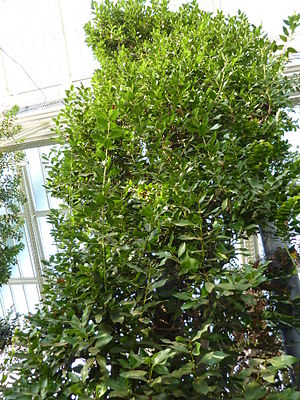Azores laurel
| Azores laurel | ||||||||||||
|---|---|---|---|---|---|---|---|---|---|---|---|---|

Azores laurel ( Laurus azorica ) |
||||||||||||
| Systematics | ||||||||||||
|
||||||||||||
| Scientific name | ||||||||||||
| Laurus azorica | ||||||||||||
| ( Seub. ) Franco |
The Azores laurel ( Laurus azorica , Syn .: Persea azorica ) is a species of the laurel family (Lauraceae).
features
The Azores laurel grows as an evergreen tree or shrub and can reach heights of 15 to 25 meters. The young leaves are a bit tomentose underneath. In contrast to real bay leaves ( Laurus nobilis ), fully grown leaves are not very aromatic. The leaf margin is smooth or slightly wavy. Along the midrib, in most of the armpits of the lateral nerves, there are small glands (domatia) that are sure to identify this species. The leaves are 12 to 15 centimeters long and 4 to 5 centimeters wide.
The flowering period extends from February to May. The Azores laurel is dioeciously separated sex ( diocesan ).
The number of chromosomes is 2n = 48.
distribution
The Azores laurel is native to all the Azores islands, Madeira and Morocco . The Azores laurel, together with other species from the laurel family, forms the main component of the laurel forests . Whether the occurrences in the Canary Islands should also be assigned to this species (as most investigators assume) or, as proposed in 2002, split into a new species, Laurus novocanariensis , is scientifically controversial (see chapter Taxonomy below).
Taxonomy
Within the genus Laurus , a distinction was traditionally made between two species, the Mediterranean common laurel Laurus nobilis and the Macaronesian Azores laurel Laurus azorica . In 2002, Rivas-Martínez and colleagues proposed in a geobotanical work that the plants from the Canary Islands should be separated from Laurus azorica and treated as an independent species Laurus novocanariensis , which, according to morphological characteristics, is more similar to Laurus nobilis than to Laurus azorica in the new sense to speak; Some of them followed them. Later investigations question this separation, however, because the two proposed taxa cannot be differentiated from one another, neither according to genetic nor morphological data. According to the genetic data, plants from Morocco in particular cannot be assigned with any certainty to any of the three species. Even the monophyly of Laurus azorica s. l. questioned, there may actually be only one species in the genus.
literature
- Ingrid Schönfelder and Peter Schönfelder : Kosmos Atlas Mediterranean and Canary Islands flora. Franckh-Kosmos, Stuttgart 2002, ISBN 3-440-09361-1
- Adalbert Hohenester and Walter Welss: Excursion flora for the Canary Islands. Ulmer, Stuttgart 1993, ISBN 3-8001-3466-7
Individual evidence
- ^ Laurus azorica at Tropicos.org. In: IPCN Chromosome Reports . Missouri Botanical Garden, St. Louis
- ↑ Salvador Rivas-Martínez, Tomás E. Díaz, Federico Fernández-González, Jesús Izco, Javier Loidi, Mario Lousã, Ángel Penas (2002): Vascular plant communities of Spain and Portugal. Addenda to the Syntaxonomical checklist of 2001. Itinera Geobotanica 15 (1-2): 5-922.
- ↑ Abdel-Moneim Ibraheim Aboel-Atta (2009): On the taxonomy of Laurus L. (Lauraceae). Evidence from Isozymes, RAPD and ISSR. Academic Journal of Plant Sciences 2 (2): 82-91.
- ↑ F. Rodríguez ‐ Sánchez, B. Guzmán, A. Valido, P. Vargas, J. Arroyo (2009): Late Neogene history of the laurel tree (Laurus L., Lauraceae) based on phylogeographical analyzes of Mediterranean and Macaronesian populations. Journal of Biogeography 36 (7): 1270-1281. doi : 10.1111 / j.1365-2699.2009.02091.x
- ↑ Paulina Kondraskov, Nicole Schütz, Christina Schüßler, Miguel Menezes de Sequeira, Arnoldo Santos Guerra, Juli Caujapé-Castells, Ruth Jaén-Molina, Águedo Marrero-Rodríguez, Marcus A. Koch, Peter Linder, Johanna Kovar-Eder, Mike Thiv ( 2015): Biogeography of Mediterranean Hotspot Biodiversity: Re-Evaluating the 'Tertiary Relict' Hypothesis of Macaronesian Laurel Forests. PLoS ONE 10 (7): e0132091. doi : 10.1371 / journal.pone.0132091
Web links
- Laurel in the flora of the Azores .
- Laurus azorica inthe IUCN 2013 Red List of Threatened Species . Listed by: World Conservation Monitoring Center, 1998. Retrieved November 13, 2013.
